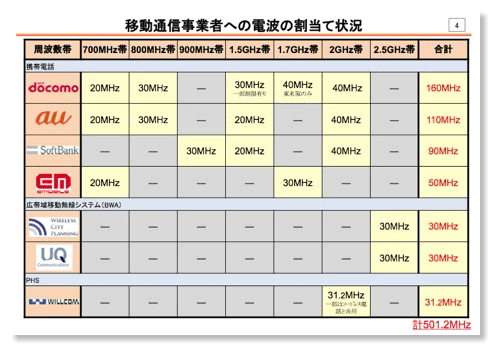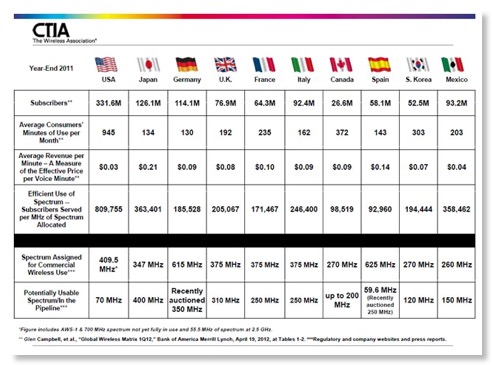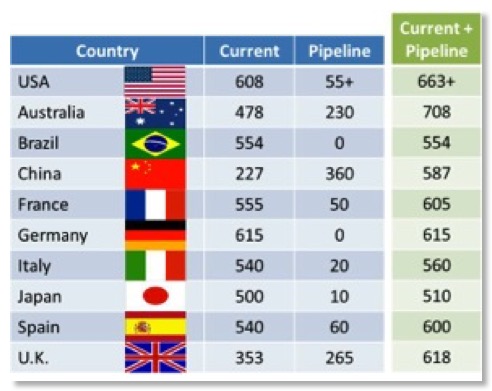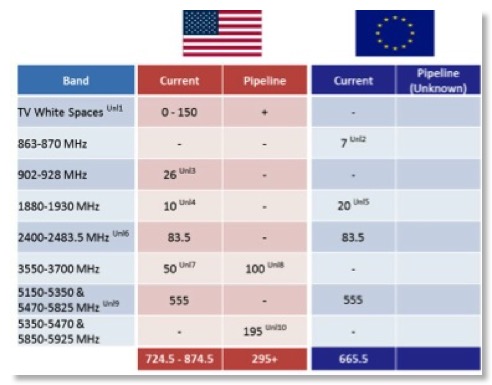Dueling Spectrum Charts - Part 2
Fred Campbell, who during the Chmn. Martin era was the chairman’s wireless advisor and then Chief of WTB, has written a blog post on the new FCC spectrum chart report. Fred questions the consistency of the new data with earlier FCC statements in the merger context:
“It appears that the FCC considers the entire 194 MHz of licensed spectrum in the 2.5 GHz band as available for mobile broadband in the US when the ratio of licensed to unlicensed spectrum and international pride are at stake, but only 55 MHz is available when the FCC considers the impact of licensed spectrum aggregation on mobile competition. If the 139 MHz of spectrum the FCC excludes from its calculations when considering mergers is excluded from the international comparison in Table 1 of the report, the total licensed spectrum in the US that is available for mobile broadband drops from 608 to 469 MHz.”
Fred ends his post with
An exercise for readers is to decide whether the Martin chairmanship was any better on being “focused . . . on facts and data”.An agency that is truly “focused . . . on facts and data” would not pretend otherwise by manipulating facts and data to satisfy its desired results. Sadly, over the last three years, the FCC has demonstrated it is no such agency.
Your blogger was in Japan last week for some speaking engagements. In a talk at ARIB he pointed out the inconsistency of the FCC’s number for Japanese mobile spectrum (500 MHz) and CTIA’s number (347 MHz) and asked which was correct. Fortunately ARIB had just finished a report, in Japanese only, on wireless spectrum use in Japan. The key chart from that report is shown below and indicates 501.2 MHz of commercial mobile spectrum at the moment. So on this point, score 1 for FCC.

On Fred Campbell’s point, I don’t follow merger issues too closely so I would welcome input from others on who is correct.
(I would be glad to share the ARIB report with others who are interested and can digest the Japanese in it.)
UPDATE
Pierre de Vries, in his Deep Freeze 9 blog, has expanded on this post with respect to alternative ways to quantify spectrum use.
Dueling Spectrum Charts
Like the “dueling banjos” scene in Deliverance, we now have dueling spectrum charts with the release this week of the FCC White Paper The Mobile Broadband Spectrum Challenge: International Comparisons, produced jointly by WTB and OET.
Reader may recall the recent criticism here of CTIA’s long used chart shown below:

Now FCC has answered back with its own accounting of international mobile spectrum use:

Now FCC does not use the absurd CTIA metric of “subscribers served per MHz of spectrum allocated” previously discussed here. And FCC adds data on unlicensed spectrum, often used by the cellular establishment for offloading traffic and thus improving service but almost always opposed by the cellular industry.

Clearly there are some major difference between CTIA’s accounting and FCC’s. For example FCC finds 608 MHz of “mobile broadband” spectrum now in the US, while CTIA can only find 409.5 MHz of “spectrum assigned for commercial wireless use”. At least in the UK the numbers are closer, FCC finds 353 MHz while CTIA finds 375 MHz. In the case of Japan, FCC finds 500 MHz of spectrum while CTIA can only find 347 MHz.
Hopefully both sides will explain what exactly they added up to get to the bottom of this disagreement. However, in the country with the world’s largest most information intensive military and with a severe post 9/11 public safety problem, it should not be surprising that less spectrum is available for commercial wireless then in, say, Brazil. If the cellular community was more open to spectrum sharing, rather than just trashing the PCAST report sharing recommendations, we could have more commercial wireless use as well as public safety/defense use.



![Validate my RSS feed [Valid RSS]](valid-rss-rogers.png)

